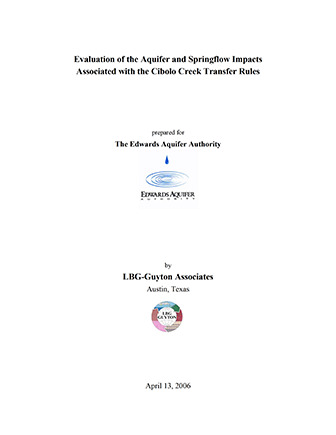Evaluation of the Aquifer and Springflow Impacts Associated with the Cibolo Creek Transfer Rules

| Author | LBG-Guyton Associates |
| Year | 2006 |
| Description | Use of data and modeling to determine effects on springflow in Comal and San Marcos Springs from Cibolo Transfers (transfers of permits from Bexar to eastern counties) |
| Publisher | LBG-Guyton Associates |
| Location | Bexar County, Hays County, Comal County |
| Cover | View Download |
| File | View Download |
| Summary |
|
The purpose of this study was to use available data and the Authority’s MODFLOW groundwater model to assess the impact to aquifer water levels and springflow from the transfer of water rights from Bexar County and the western counties to Comal and Hays Counties. Water right transfers from Bexar County and west into Comal and Hays Counties are referred to as “Cibolo transfers” because Cibolo Creek is the geographic feature between the two areas. The study was completed on April 13, 2006 by LBG-Guyton Associates, Austin, Texas. This study was designed to use available data and the EAA MODFLOW groundwater model to assess the impact of Cibolo transfers on aquifer water levels and springflow. An evaluation of current permits and transfers show that 58 percent of the transfers originate in Bexar County, followed by Medina (26%) and Uvalde (16%). Transfers make 0.51 percent of total permits. Comal County receives the largest portion of transfers (94%) followed by Hays (4%), and Guadalupe (2%). Assessment of the faults and springs in the MODFLOW model indicates that the model is generally consistent with the current conceptual model of the aquifer. Based on the modeling methodology used for this study, it is clear that Cibolo transfers impact springflow from San Marcos and Comal Springs. The model results indicate that the withdrawal location of the transfer can affect the amount of impact that the transfer has on flow from individual springs and on the total springflow. Cibolo transfers generally have a negative effect on San Marcos springflow because San Marcos Springs are located at the end of the flow system, and thus are generally affected by upgradient withdrawals. Model results indicate that on average, San Marcos springflow may be decreased from 0 to 92% of the transfer volume. In seasonally high summer pumping, San Marcos springflow may be decreased from 4 to 313% of the transfer volume. Model results indicate that on average, the impact to Comal springflow ranges from a 51% increase to a 35% decrease of the transfer volume. During peak summer pumping, the maximum impact to Comal springflow ranges from an increase of 7 percent to a decrease of 203 percent of the transfer volume. Water levels in the Bexar County index well (J-17) increase slightly due to transfers, suggesting that CP/DM triggers for the San Antonio pool would be reached slightly later during any particular dry period then they would have prior to the transfer. |
Search for Documents
Advance Search
Explore EAA's Scientific Reports
- All Reports
- Geomorphology and Caves
- Weather Modification
- Geology
- Water Use and Conservation
- Geochemistry
- Water Resources Planning and Management
- Floods and Drought
- Water Quality
- Climatology
- Surface Water / Groundwater Relationship
- Biology
- Springs, Groundwater Discharge
- Archaeology
- RZ Protection
- Aquifer Levels
- Remote Sensing
- Precipitation
- Overview Studies
- Modeling
- Hydrology and Hydrogeology
- History
- Groundwater Recharge, Recharge Zone
- Groundwater Movement
